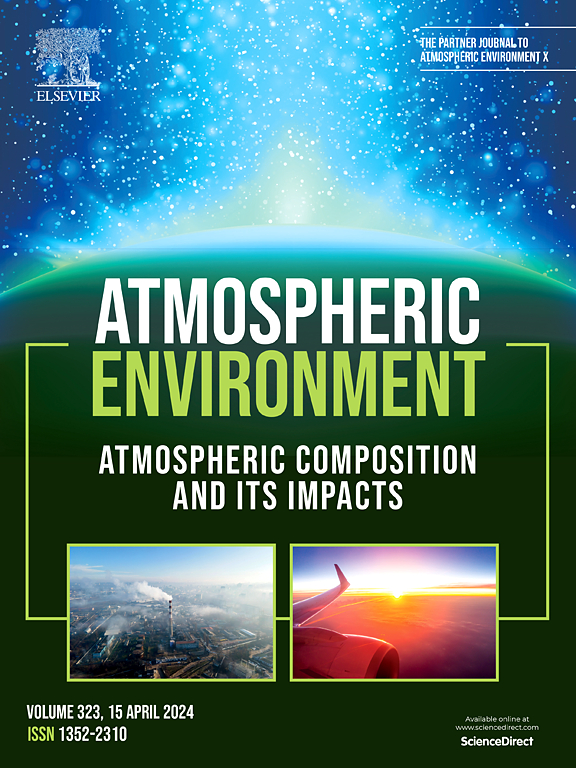Diurnal NOx emission underestimation constrained using overlapping TROPOMI swaths
IF 3.7
2区 环境科学与生态学
Q2 ENVIRONMENTAL SCIENCES
引用次数: 0
Abstract
Existing remote sensing techniques provide insights into the global-scale daily distribution of tropospheric nitrogen dioxide (NO2) vertical column densities (VCDs). However, they struggle to quantify the diurnal variation of nitrogen oxide (NOx) emissions, crucial for understanding air quality and atmospheric environment. We present a novel mass-conserving inversion method and sampling strategy that uses the overlap between adjacent swath edges of polar orbiting satellite Sentinel-5P/TROPOMI to quantify five years (May 2018 to April 2023) of global diurnal NOx emissions over upper mid-latitude regions. We account for first-order thermodynamics, chemical decay, and advective and pressure induced transport, allowing a flexible, rapid, and reliable alternative to complex models. By sampling two daytime NO2 VCDs across consecutive orbits approximately 100 min apart, emissions rates are computed for both the 100-min window around midday as well as the 24-h daily cycle. Robust climatological estimates and uncertainty quantification are enabled over major urban areas like New York, Benelux, North China Plain, and Almaty. The estimated diurnal emissions variation show that 100-min emissions are 21 %–105 % higher than 24-h averages, which reveals differences in chemical lifetime from different energy sources, unique spatial-temporal weekend effects over China, USA, and Europe, and see-saw of emissions underestimation over cleaner regions and improvement over polluted regions. The results uncover significant new findings impacting atmospheric chemistry, remote sensing retrieval, environmental policy, and climate science respectively.
利用重叠TROPOMI条约束日NOx排放低估
现有的遥感技术可以深入了解对流层二氧化氮(NO2)垂直柱密度(vcd)的全球日分布。然而,他们很难量化氮氧化物(NOx)排放的日变化,这对了解空气质量和大气环境至关重要。我们提出了一种新的质量守恒反演方法和采样策略,该方法利用极轨卫星Sentinel-5P/TROPOMI相邻带状边缘之间的重叠来量化中纬度地区5年(2018年5月至2023年4月)全球氮氧化物日排放量。我们考虑了一阶热力学,化学衰变,平流和压力诱导的输运,允许灵活,快速和可靠的替代复杂的模型。通过在连续的轨道上采样两个白天的二氧化氮vcd,间隔大约100分钟,计算正午前后100分钟窗口和24小时每日周期的排放率。对纽约、比荷卢、华北平原和阿拉木图等主要城市地区进行了可靠的气候估计和不确定性量化。估算的日排放变化表明,100 min排放量比24 h平均值高21% ~ 105%,这揭示了不同能源的化学寿命差异,中国、美国和欧洲独特的时空周末效应,以及清洁地区的排放低估和污染地区的改善之间的波动。研究结果揭示了在大气化学、遥感检索、环境政策和气候科学方面的重大新发现。
本文章由计算机程序翻译,如有差异,请以英文原文为准。
求助全文
约1分钟内获得全文
求助全文
来源期刊

Atmospheric Environment
环境科学-环境科学
CiteScore
9.40
自引率
8.00%
发文量
458
审稿时长
53 days
期刊介绍:
Atmospheric Environment has an open access mirror journal Atmospheric Environment: X, sharing the same aims and scope, editorial team, submission system and rigorous peer review.
Atmospheric Environment is the international journal for scientists in different disciplines related to atmospheric composition and its impacts. The journal publishes scientific articles with atmospheric relevance of emissions and depositions of gaseous and particulate compounds, chemical processes and physical effects in the atmosphere, as well as impacts of the changing atmospheric composition on human health, air quality, climate change, and ecosystems.
 求助内容:
求助内容: 应助结果提醒方式:
应助结果提醒方式:


